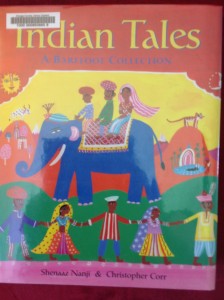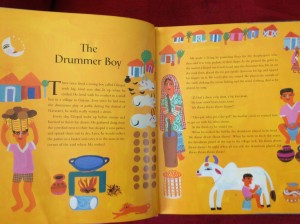If children’s books can promote emotional intelligence and reading comprehension, “Drummer Boy” from Indian Tales delivers.
This post will contain spoilers. 😉 I will tell almost the whole story of Ghopal, a budding merchant, and his quest to get a drum to make his heart go boom, boom, boom!
My son, 3 years 3 months, absolutely loves folk and fairy tales. When we go to the library, I go to this section now, which is in the older children’s section, and let him pick out a book. He loves classics like Cinderella. He also picked out Panda and Their Chopsticks, which we found in this section. And this last time, he picked out Indian Tales.
The story is about Ghopal, who does chores all day long, and longs for a drum. He asks his mom for one, who tells him it won’t “fill his stomach.” But he wants a drum to make his heart go boom, boom, boom. His mom makes pakoras, which are a little like fried onions.
Ghopal, the budding merchant, eats only some of the pakoras and devises a plan. He sets off on his ways to the market to sell them. On the way, he first sees a crying, hungry baby. Feeling sorry for the little child, Ghopal gives him some pakoras. The mom is so grateful and gives Ghopal a pot. It keeps going like this, where Ghopal helps a woman in a domestic violent dispute, who gives him her shawl for the pot he gave her. Then Ghopal meets a merchant, who gives him a horse for the shawl. Ghopal then sees a wedding, where the groom is missing. Ghopal offers to go get the groom. The bride, elated with joy, asks Ghopal what he wants. “A drum!” Ghopal gets his drum, and still sells his pakoras at the market, coming home with a drum, a horse, and money for his mom! Throughout the book there a fun little diddy: “I wish I had a drum. A big bass drum. It would make my heart boom, boom, boom. Taki daki doom doom doom.”
The emotional intelligence learning potential in this book is huge. My son has a baby sister who, well, cries sometimes. He knows very well what a problem it is to calm her down and how desirable it is to do this. He makes plays with some of his figurines where a mommy figurine calms down the baby figurine. I talk to him about what type of things make his sister happy or sad (pulling her leg makes her sad; making funny faces makes her happy.) He takes it upon himself to try to make her happy when she is sad, usually by dancing, playing the trumpet, or doing “funny games.” So to hear about how Ghopal made the little baby happy just melts him. He loves it.
He is also frightened by the mean man yelling at his wife, and loves that Ghopal helps her. And when Ghopal gets his drum – oh boy! My son says, “And then he was HAPPY!!!!” And Ghopal then goes on to sell pakoras to help his mom, making his mom happy. Happiness all around in this book.
This is one of the first books we have read where I don’t primarily rely on any pictures to tell it. I just read it, and there are several paragraphs per page. But he sits for the whole thing, entranced. The pictures there do help, though, so I can explain words like what a “patty” (like a hamburger patty) is.
As is recommended, to promote reading comprehension, I don’t just read the book, we also talk about the book. The easiest way is to recap the book, in my own words, without using the book. To see if he understands the story, I pepper him with easy questions while reading it. For instance, “And what does the mommy give Ghopal?” There is no doubt the my son understands when Ghopal gets his drum. I always let him answer, “And then what does he get?” “A DRUM!”
When I read books, I try to match my voice to the word written about how a person says something. If someone is excited, shocked, yelling, etc., I try to match my voice to it. I do not have a particularly gregarious personality. I prefer non-fiction to fiction. I enjoy doing things like analyze data. I would take coffee with 1, at most 2, friends over a party any day. Yet by matching my voice to the emotion written, I find I can tell a captivating, almost hypnotic story to my son. I largely see it as a vocabulary lesson: to understanding “yelling,” I yell. But it certainly helps the story come alive.
Having favorite stories has come in handy in so many ways. When my son was 2, there were many times that I calmed him down by telling him his favorite story, Cinderella. Ghopal helps us too. He recently locked me out of a public bathroom stall and then clearly needed my help. I convinced him to let me help him by promising to tell the story of Ghopal while I helped him.
Later, when out in public, he asked me, “If I sit on the potty, will you tell me about Ghopal?” Ha!

